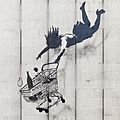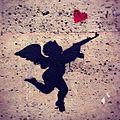Street art facts for kids
Street art is a type of art that is created in public places, usually outside of traditional art galleries. It's like a big art show happening all around you in cities! It can include paintings, drawings, sculptures, or even performances.
Some street artists create temporary art, like drawings on the ground with chalk or musical performances. Other artists create more lasting works, often called "urban art," using tools like spray cans or stencils on walls.
Contents
Street Art in New York City
In the 1970s, artists in cities like Philadelphia and New York City started using spray cans to create art on walls and subway trains. This was a new way to express themselves. While some people saw it as art, others considered it vandalism because it was done without permission. One famous artist from New York who wrote his name, "SEEN," on many subway trains became very well-known.
Street Art in Paris
The famous street artist Banksy once said that the street art in Paris influenced him a lot. He thought that the street art movement really began during a small revolution in May 1968 in Paris. He also mentioned another important stencil artist named Blek le Rat, who was a pioneer in using stencils for street art.
Land Art
Land art is a special kind of art where the natural landscape becomes part of the artwork itself. Artists use natural materials like rocks, soil, and branches to create their pieces right in nature.
A famous artist couple, Christo and Jeanne-Claude, created many large-scale art projects. In 1962, they made an artwork in the streets of Paris to protest against the Berlin Wall. Later, in the 1970s, they created huge land art projects in the California desert, like building a very long fence. In 1985, they wrapped the oldest bridge in Paris with fabric. They had to get permission for years to do this, so it was official, but it still caused a lot of discussion!
Art and Messages
After the Berlin Wall came down, an artist named Shepard Fairey started gluing pictures of a French wrestler named André the Giant in California. It became very popular, and soon people were making stickers of the wrestler's image. Many skateboarders thought it was "cool."
Later, in the late 1990s and early 2000s, big meetings of the World Trade Organization (WTO) happened in cities like Seattle, Prague, and Genoa. Young people who protested at these meetings used art and creative techniques to share their messages. They called this "Absurd Propaganda" or "culture jamming." After the events of September 11, 2001, this kind of art started to have a stronger political meaning. People began to call it "artivism," which is a mix of art and activism.
Invading Space with Art
In 1999, an artist known as Space Invader (who got his name from a video game) started placing small mosaic artworks in Paris. He began by putting them in famous places like the Louvre Museum. Soon, French TV showed his work, and he started placing his mosaics in cities all over the world.
His art is not temporary; it's made to last, but it's also very small and discreet. Because of this, authorities often let him continue his work. Only in Amsterdam did the city decide to remove his mosaics. Space Invader also created a website where people from around the world could share photos and participate in his project. He even invited Shepard Fairey to Paris in 2003.
Images for kids
-
Germany's Berlin Wall (shown 1986) was a target of artists during its existence (1961–1989)
-
The 2010 recreation of Keith Haring's original 1982 mural; New York City's Bowery Mural wall at Houston Street and the Bowery
-
Banksy's Shop Until You Drop, Mayfair, London. His politically subversive street art has appeared in the UK and around the world.
-
Street art in Bonifacio Global City, Philippines
-
Shepard Fairey: André the Giant has a Posse, sticker art (c.1989)
-
Morley, Los Angeles (2010)
-
Barry McGee (Twist), LACMA parking garage (c.2005)
-
Work of Brazilian artists Os Gêmeos, in Lisbon, Portugal (2011)
-
Street art by WATTTS in Paris
-
Graphic-Domain in Heidelberg by Nicola Pragera
-
Mural by BLU, Gaza Strip, Prague
-
Urban art in Katowice, Poland
-
Street art in the old city of Prizren, Kosovo
-
Work by Bleeps.gr in Athens
See also
 In Spanish: Arte urbano para niños
In Spanish: Arte urbano para niños



























